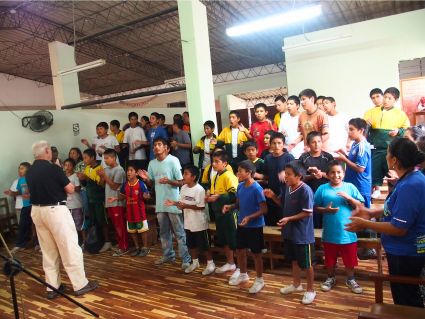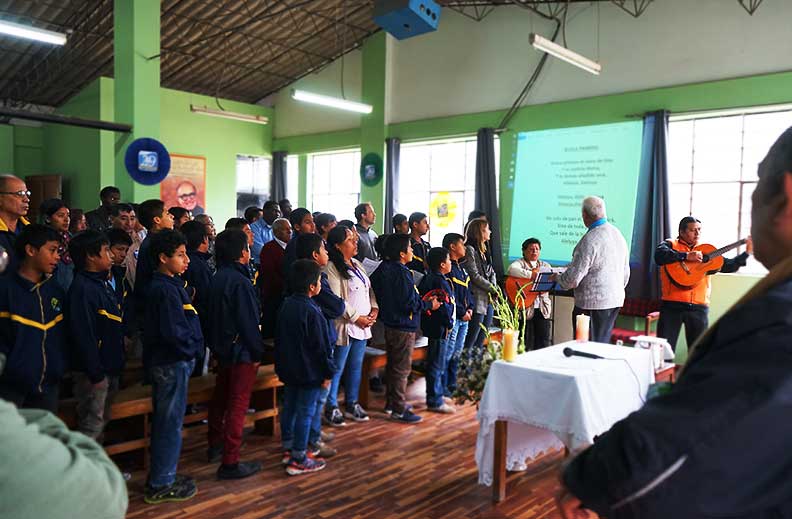
Recruitment of Children and Adolescents
Initially, the recruitment of children was carried out through street outreach in Plaza San Martín and other areas where street children congregate. Gradually, as CIMA grew, this practice was phased out.
Nowadays, word-of-mouth communication is the main method. Children and their families hear about CIMA through friends, neighbors, organizations, parishes, other homes, and municipal child and adolescent protection agencies that direct them to the home.
Generally, it is mothers, fathers, or other family members who bring the children.
Exceptionally, some children come on their own initiative.
Phases of Intervention
The child’s rehabilitation process does not involve formal stages with set timelines. Instead, the process is adapted to the needs of each child, providing personalized care.
- Admission to the home is voluntary. A child’s enrollment in CIMA cannot occur without their consent. Upon entry, the child or adolescent signs a commitment agreement to accept their admission. It is they who decide both verbally and in writing. The only exception concerns children sent by INABIF authorities. In this exceptional case, the child is subject to the regulations that apply in CARs, and their admission, discharge, and leave are conditioned on the authorization of the competent administrative and/or judicial unit (cf. Legal Framework). The duration of stay at CIMA ranges from 6 months to 3 years. In some exceptional cases, the child may stay longer if the circumstances that led to their admission to CIMA have not changed.
The first step upon a child’s admission to CIMA involves a psychosocial evaluation interview conducted by the psychologist, social worker, and nurse, to make an initial diagnosis of the child’s situation and determine whether CIMA is the most suitable institution for the child, based on the nature of their problems. The child must also demonstrate awareness of their issues and express a willingness to change. Written and signed authorization from the family or contact person who brought the child is also required. A provisional admission form, including the reasons for admission, a physical description of the child, and observations from the psychologist, social worker, and nurse, is submitted to the coordinator, who assigns the child to a pavilion based on their age and the nature of their problems. Subsequently, a more in-depth diagnosis of the child’s situation will be made by the CIMA team.

- The child’s integration into their pavilion is overseen by the tutor. The tutor welcomes the child, explains the functioning of CIMA, and introduces them to their housemates. During the first two weeks, the child rotates through the various workshops to later choose the ones they like best. They are then given their workshop and leveling schedules. Generally, the child’s adaptation to the functioning of CIMA (rules of coexistence, discipline, schedules…) takes a few months.
- The child’s progress is monitored daily by the tutors and teachers through behavior evaluation systems to detect potential problems. Recurrent behavioral issues are often signs of a deeper discomfort. Tutors fill out an occurrence log daily, noting the child’s behavior (punctuality, respect for others, task completion). Similarly, the leveling and workshop teachers provide the tutor with a daily sheet rating the child’s behavior from 1 to 5. Positive behavior evaluations determine the incentives the child receives (such as playtime, television time,…).
- Each week, the children’s and adolescents’ behavior is evaluated to encourage those with good conduct. Tutors categorize the children in their pavilion as positive, neutral, or negative. “Positives” are those who behave well and have a proactive, positive influence on others, unlike “neutrals” who behave well but do not seek to influence the group. “Negatives” are those who have shown a consistent lack of attention to what the tutor or teachers say or have exhibited inappropriate behavior. The “positives” receive applause and an invitation to a restaurant as a reward for four positive evaluations. Negative evaluations do not result in penalties but help identify children with recurring behavioral problems. If a child accumulates four negative evaluations in a short period, the pedagogical team (coordinator, tutors, teachers, psychologists, and social workers) convenes a meeting with the child to urge them to improve their behavior on specific points.
- If a team member identifies a problematic situation, they talk directly with the child to identify the causes of the problem and try to solve them. If necessary, they refer the case to the psychologist. In more severe cases (such as aggression or theft), the entire team meets with the child to analyze the situation with them and find a solution.
- Depending on the child’s age, length of stay at CIMA, and situation, corrective measures may vary: helping on the farm, physical exercises (running around the sports field), or additional tasks (such as cleaning). These corrective measures are considered part of behavioral therapy. The goal is to change the child’s behavior, not to punish them.

